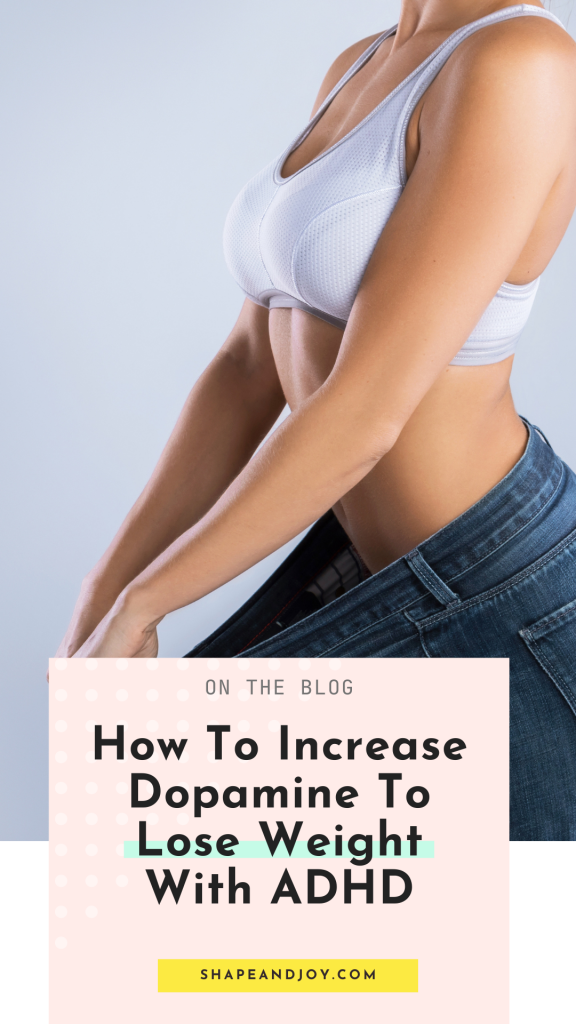This post may contain affiliate links, which means that I may earn a commission if you click on the link, with no cost for you. It’s one of the ways I support my blog. You can read more about this here.
I remember the frustration so clearly – I’d set a plan to eat healthy, but by midday, I’d be reaching for the nearest snack without even thinking. It wasn’t until later that I realised it wasn’t just about willpower; it was about understanding how to increase dopamine – because ADHD changes the game.
Our brains are wired differently, and impulsive choices or the constant need for novelty can make traditional weight loss advice feel impossible to stick to.
But here’s the thing: it’s not about the typical “eat less, move more.” It’s about understanding how ADHD impacts dopamine – that all-important brain chemical linked to motivation and reward.
When you get it working for you instead of against you, things can start to FINALLY click.
So, in this post, I’ll discuss:
- Why regular weight loss tips might not work for ADHD brains
- How to boost dopamine to help with healthier choices
- Simple strategies to improve both your weight and well-being
Let’s get into ‘How to Increase Dopamine With ADHD To Lose Weight’!

Why People with ADHD Struggle with Weight Loss
Dopamine Dysregulation and Cravings
The first step in learning how to increase dopamine is to understand dopamine a little bit more.
Dopamine is like the brain’s little happiness button. It’s what makes you feel good when you do something fun or rewarding, like eating a packet of Oreos or finally finishing that task you’ve been avoiding.
But if you’ve got ADHD, that dopamine system can be a bit, well, wonky. It’s like your brain is always looking for that next burst of pleasure but isn’t getting it as easily as it should.
And guess what gives you that quick dopamine hit? Yep, those processed, sugary, and salty foods we all love. They’re literally designed to light up your brain’s reward centres.
So when you grab a bag of crisps or a chocolate bar, your brain is like, “Oh, this is amazing! More, please!” But here’s the kicker: that rush doesn’t last long, and once it’s gone, your brain starts looking for the next hit.
Before you know it, you’re reaching for another snack, and then another.
It’s not just about lacking willpower—your brain is wired to keep craving those foods because they’re giving it the dopamine it’s missing. And the more you give in, the more it reinforces that cycle.
I actually HIGHLY recommend reading the book ‘Salt, Sugar, Fat’ by Michael Moss, it goes into a lot more detail about how the major food companies are finding the perfect balance of sugar and fat (the “bliss point”) to keep us hooked.
So, you end up overeating, gaining weight, and wondering why healthy habits just don’t stick.
Impulsivity and Food Choices
Impulsivity is practically the hallmark of ADHD. And when it comes to food, that impulsiveness can lead to some questionable choices.
You know the drill – you plan to eat healthy, but suddenly, you’re elbow-deep in a bag of crisps or ordering a pizza. It happens to the best of us!
Impulsivity can leave you constantly thinking about your next meal or snack, and I know how overwhelming that can be! If this sounds familiar, I’ve written more about how to shift your focus in How to Stop Thinking About Food: Stop Obsessing, Start Enjoying!
Executive Functioning and Planning
Executive functioning is like your brain’s personal assistant – except with ADHD, it’s more like having a disorganised assistant who’s lost your calendar. Planning meals, grocery shopping, and meal prepping can feel overwhelming.
Maybe you’ve tried meal prepping, only to find a bunch of forgotten containers in the fridge days later. Your brain has its own schedule, and it doesn’t always line up with your plans.
(BTW – If you’re looking for some help with meal prep, check out my post on ADHD Meal Planning where I break down how to make it simple, flexible, and way less stressful!)

Emotional Dysregulation and Emotional Eating
With ADHD, emotions can flip like a switch. When you’re stressed, overwhelmed, or frustrated, it’s tempting to turn to food for comfort.
Emotional eating becomes a way to soothe those intense feelings, even if it’s just for a moment.
Turning to food when emotions run high is so common, especially with ADHD. But managing stress eating can make a world of difference. I go into more detail in my post: Stress Eating? Experience a Healthier, Happier Life.
1. Dopamine-boosting foods and Nutrients
Certain foods can help support dopamine production.
Tyrosine and phenylalanine (amino acids) are the building blocks of dopamine, while vitamins and minerals like B6, magnesium, and iron help convert these into dopamine.
Tips for Including Dopamine-Boosting Foods in Your Diet
- Add lean proteins like chicken, turkey, fish, and eggs to your meals.
- Load up on colourful fruits and veggies like bananas, avocados, berries, and leafy greens.
- Whole grains and healthy fats from nuts, seeds, and fish can also help.
For more ideas on nourishing meals that support your health journey, you can check out my post: Wholesome Foods for a Happy and Sustainable Weight Loss.
2. High-Intensity Interval Training (HIIT)
HIIT workouts are AMAZING for people with ADHD.
They’re quick, intense, and varied – perfect for short attention spans.
Plus, the bursts of activity can stimulate dopamine release, helping you feel more motivated and focused.
3. Novelty and Variety in Exercise
ADHD brains crave novelty, so repetitive workouts can get boring fast. Mixing up your routine can make exercise more exciting and keep you motivated.
Tips for Incorporating New and Fun Exercises
- Try new sports or activities like rock climbing, paddleboarding, or dance classes.
- Alternate between cardio, strength training, and outdoor activities to keep things fresh.
If you’re looking for more fresh ideas to keep exercise exciting, head over to my post: 7 Joyful Movement Ideas That Will Make Exercise Exciting!
4. Mindful Movement Practices

Yoga, with its slow, intentional movements, can help boost dopamine levels while improving focus and mood.
It’s a great way to connect physical activity with mindfulness.
Check out my guide to gym bag essentials for women—because a well-packed bag makes every workout smoother.
5. Structured Meal Timing
Eating at consistent times can help regulate dopamine and prevent impulsive eating. If you often forget to eat until you’re ravenous, try setting alarms or prepping meals in advance.
Tips to Help Stick to a Meal Plan
- Set reminders to eat.
- Batch cook and keep healthy snacks handy.
- Focus on simple, quick-to-prepare meals.
6. Goal Setting and Dopamine Rewards
When you set goals and experience success, whether big or small, your brain releases dopamine, creating a sense of satisfaction, pleasure, and motivation.
By rewarding yourself for achieving goals, you create a positive feedback loop that reinforces desired behaviours and increases motivation to continue working towards your goals.
Want to make boosting dopamine a daily habit? The 30-Day Dopamine Boost Challenge guides you through simple, powerful actions to elevate your dopamine levels and stay motivated—all in just one month.
Break larger goals down into smaller, more manageable steps or milestones. This makes them less overwhelming and allows you to celebrate progress along the way, keeping motivation high.
Choose rewards that are meaningful to you and aligned with your weight loss goals. These could include non-food rewards like a new workout outfit, a mini shopping spree, a day off, or just something that’s fun to you that you don’t get to do much.
Good food and movement can make all the difference, especially for women with ADHD. Dive into my brain-boosting tips for women with ADHD post to learn how to make smart choices for focus and energy!
7. Sleep Hygiene
Poor sleep can mess with dopamine levels, leading to more cravings and less motivation. Make sleep a priority by setting a consistent bedtime and creating a calming routine.
And if mornings are a struggle, check out my post on creating a low dopamine morning routine—it’s packed with tips to help you boost focus and get going even on those tough ADHD days.
8. Mindfulness Meditation
Even just a few minutes of mindfulness a day can help regulate emotions and improve focus. If sitting still isn’t your thing, try active meditation like yoga or walking.
9. Social Support
Positive social interactions can boost dopamine and keep you motivated. Whether it’s a workout buddy or a friend to celebrate wins with, having a support system makes a HUGE difference.
Having a support system can make such a big difference, but it’s also important to celebrate the smaller wins along the way. I dive deeper into this in my post: Non-Scale Victories: The Hidden Wins That Matter Most.
How to Increase Dopamine With ADHD To Lose Weight: Conclusion
Managing weight with ADHD requires a different approach, one that works with your brain, not against it. From dopamine dysregulation to impulsivity, ADHD creates unique challenges, but with the right strategies, you can take control of your health journey.
Be patient with yourself – weight loss is a slow process, and it’s even trickier when you have ADHD. By focusing on dopamine-boosting habits and making small, manageable changes, you’ll find a path that works for you.
Further Resources
Studies to Support ‘How to Increase Dopamine With ADHD To Lose Weight’
Dopamine Dysregulation and Cravings: Individuals with ADHD often experience dysregulated dopamine systems, which can drive impulsive eating behaviours and cravings, especially for high-sugar and high-fat foods that give quick dopamine boosts. This behaviour reinforces the cycle of overeating, making weight loss difficult (Franco et al., 2021).
ADHD, Impulsivity, and Food Choices: Studies have found that ADHD symptoms, influenced by dopaminergic dysfunction, can predict hedonic eating, which in turn leads to higher body mass index (BMI) (Patte et al., 2020).
Executive Function and Meal Planning: The link between ADHD and obesity is significantly influenced by deficits in executive functioning, which includes difficulties in meal preparation and adherence to weight loss programs (Franco et al., 2021).
Emotional Dysregulation and Emotional Eating: ADHD is associated with emotional dysregulation, which can lead to emotional eating as a coping mechanism. This emotional dysregulation is partially linked to dopaminergic dysfunction, which affects reward processing and emotional responses (Cortese et al., 2012).
Strategies to Boost Dopamine: HIIT has been shown to stimulate dopamine release, improving motivation and focus in individuals with ADHD (Simonds & Cowley, 2019)


